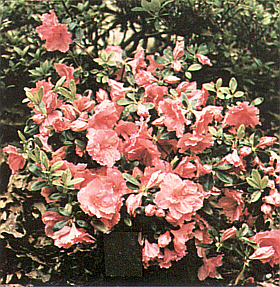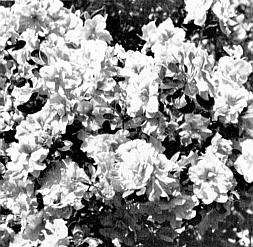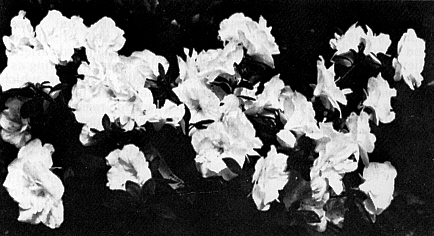The Why and How of the Linwood Hardy Azaleas
G. Albert Reid, Linwood, N.J.
In 1950 Charles Fischer, Jr., Doctor of Floriculture, came home from Cornell University and took over management of the family greenhouses in Linwood, N.J. There were 4-1/2 acres under glass, with about one third being used for dormant storage of tender Indica, Pericat, and Rutherfordiana azaleas. The hardy varieties grown at that time consisted mostly of 'Hinodegiri', 'Coral Bells', 'Snow', 'Herbert', and a few others. The florist trade demanded the showiest Indicas and the like which were not hardy enough in New Jersey to survive outdoors for two or three years until large enough to be forced.
In 1951 Fischer decided that there should be azaleas hardy enough to stand our winters and be comparable to the tender varieties in flower size and beauty. And that is "Why" the Linwood Hardy breeding project was begun.
With this in mind, Charles Fischer started crossing tender varieties on hardy ones in the spring of 1951 and continued in 1952. He planted all the seed, but, unfortunately, kept few records the first two years. Though none of these first attempts produced anything of value, we decided to cover the same ground again to make sure we had not overlooked a valuable combination of genes and also to keep our records straight
In January, 1953, I entered the scene. Though Charlie still believed in his idea, he was quite willing to pass on the tedious process of pollinating, growing, and waiting, and I was equally willing to accept the challenge. Since that time, the production of the Linwood Hardy azaleas has been my baby.
Charlie has never lost interest in the project and always helps in evaluating new seedlings
In the fifteen years I was with Fischers, our search was for florist type plants that could be grown in the field for two or three years, then potted and forced in the greenhouse. Nothing was container-grown at that time. In the early 1960's, we had 10 to 10-1/2 miles of 6 foot beds of azaleas growing in the field, with over a fourth of a million (250,000) plants in production.
There is no family tree or common background for the Linwood varieties. They are a heterogeneous conglomeration of azalea crosses, including back crosses and sibling crosses when trying to bring out a desired characteristic.
After the first year in my home, the seedlings of the Linwood Hardy group went into the field and were treated the same as other hardy varieties. The only way to find out if a new plant is hardy is to let it winter out and see if it survives.
At the peak time of our project, we had over 6000 individual seedlings in the field that came from a single season's crosses. One year we grew 2000 plants, the result of the 1957 crosses, on to four years of age, and not a single one was worth saving.
As an example of the surprises we had, in 1956 we crossed "Amber Glow', a large single hose-in-hose deep salmon flower on an unnamed Linwood double dark pink flower, and nearly every seedling had white flowers! 'Garden State White' and 'Linwood White' are two of them as well as three other unnamed whites grown for the florist trade, but not winter hardy.
Because of the harsh treatment we gave the seedlings, we seldom got the first bloom until the fourth year. After selecting a plant, we gave it another four years of testing before putting it on the market. We not only tested for hardiness, but also for plant habit, foliage, flower life, and time needed for forcing, all with the retail florist in mind.
Attempts to cross Mollis and Ghent hybrids on
R. obtusum
varieties resulted in either non-viable seed or apomixis. However, in 1968 I was successful in getting offspring, using an apomict pollinated by
R. arborescens
(known as wild honeysuckle in New Jersey). This cross resulted in many plants with a wide range of flower colors in their second year of field testing. They bloom in late June and July, along with the beautiful deciduous varieties, but are evergreen!
You know, of course, that the more complicated the flower structure is, the longer the bloom tends to last. We tried for semi-doubles and doubles, and if hose-in-hose were added, it was that much better.
When I retired from Fischers in 1967, I believed the homeowner would be interested in newer and better azaleas than he had been able to buy for his garden. Accordingly, Fischer kept the Linwood varieties best suited to the commercial florists' needs, and I concentrated on plants better suited for outdoor planting.
And that's mainly the "How" of the Linwood Hardy Azaleas.
The name Linwood Hardy implies winter hardiness in Linwood, N.J. Actually, they range in hardiness from zones 6 to 8. The ones I grow are good in zones 6 and 7.
I believe the most important thing in azalea culture is to prepare the planting area properly before planting. During the growing season, check for insects and the need for water, but otherwise let them alone. Azaleas don't like to be fussed with.
There are two reasons for planting azaleas. One is for a display, a hedge, a row or bed for the enjoyment of the public. This not only improves the neighborhood, but gives the owner a great deal of satisfaction. Most of the old standard varieties are fine for this type of planting as well as some of the Linwood's, which, in general, hold their bloom longer.
The second reason is for the owner's own enjoyment and the pleasure of having something better and different. That is where the Linwood azaleas really shine.
Named Varieties of Linwood Hardy Azaleas"
1. L-1. Semi-double lavender rose, fall bloomer as well as spring (A3 x K28).
2. 'Garden State Pink'. Compact plant. ('Dawn' x 'Hino crimson') hose-in-hose.
3. 'Garden State Glow'. More rangy than 'Garden State Pink'. ('Salmon Spray' x 'Hino crimson') hose-in-hose.
4. 'Garden State Salmon'. As near orange as possible, hose-in-hose.
5. 'Salmon Pincushion', double. Flowers in trusses shaped like pincushions. (K28 x A3).
6. 'Garden State White'. Fast growing hose-in-hose white. ('Amber Glow' from Bobbink & Atkins x A3).
7. 'Linwood White'. Formal, flat double hose-in-hose white, no stamens, tall. ('Amber Glow' x A3).
8. 'Improved Linwood White'. Enormous double hose-in-hose heavy white, medium bush. ('Crimson King', (or K18) x A3).
9. 'Pink Pincushion'. Flowers in trusses, bright double pink. (K28 x A3).
10. 'Improved Linwood Pink'. Fringed hose-in-hose pink, ('Rose Greely' x K28) x A3).

|
|
'Improved Linwood Pink'
Photo by Albert Beith |

|
|
Fig. 48 'Linwood Lavender'
Photo by Albert Beith |

|
|
Fig. 49 'Hardy Gardenia', Linwood Azalea
Photo by Albert Beith |
11. 'Linwood Lavender'. Lavender pink, semi-double, medium bush. ('Amber Glow' from Bobbink & Atkins x A3).
12. 'Hardy Gardenia'. Prostrate, exceptional white, double hose-in-hose. Very slow grower. (A3 x E9).
13. 'Linwood Salmon'. Fringed hose-in-hose, dark salmon. Needs shade, blooms for four weeks. (A3 x ('Rose Greely' x K28).
14. 'Garden State Red'. Hose-in-hose with overarching branches. 'Hiawatha' x 'Glacier') x ('Hexe' x Vervaeniana).
15. 'Linwood Pink'. Hose-in-hose, patented. (('Rose Greely' x K28) x A3).
16. 'Doctor Curtis Alderfer'. Semi-double red, hardy in zone 8, (K28 x Koenig), patent #2016.
17. 'Linwood Blush'. Semi-double, hose-in-hose. Light salmon, hardy in zone 8, ('Salmon Spray' x 'Jean Haerens').
18. 'Nellie'. Semi-double, hose-in-hose. Pink, hardy in zone 8, patent #2021. Forces easily for Christmas, ('Prince George' x 'M. R. Mulford').
'These names have not been registered and some may be changed. K28: Macrantha from Bobbink and Atkins, very hardy.K7: Salmon SprayA3: Fischer Hybrid Azalea E9: Hexe x Vervaeniana